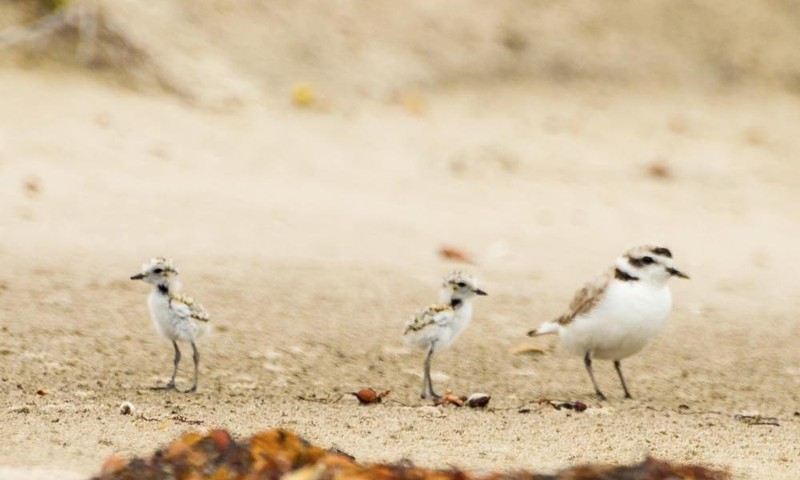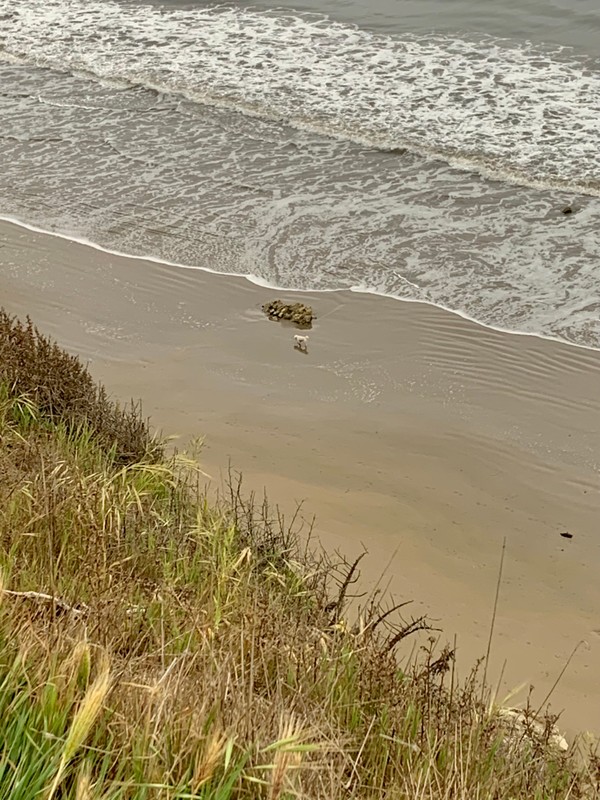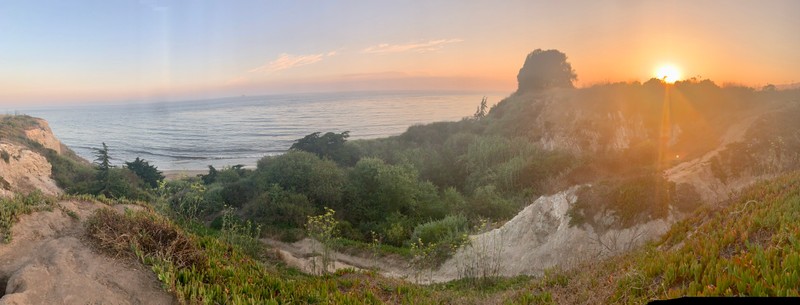Sands Beach
Introduction
Author-Uploaded Audio
Listen to a narration of this entry's description by Nicky Rehnberg.
Text-to-speech Audio
Recommended Time: 30 minutes
Consider wearing hiking sandals and clothes that you do not mind getting dirty or wet! Also, always look up tidal conditions before going to the beach.
There are a few ways that you can get to Sands Beach from Ellwood Mesa. Some of these paths can be unstable or can completely disappear, depending on recent weather. The three main paths from Ellwood Mesa are:
- Past the last tour stop at the Eucalyptus Grove. When you follow the gravel road and head towards the ocean and Isla Vista, you should see a path down to the beach.
- At the brick gate. Keep walking on the bluff trail, away from Isla Vista. You will see ruins of a brick gate before the Eucalyptus Overlook stop. Walk down the path – it is still steep – but this is the safest way down from the bluff.
- After the Eucalyptus Overlook. If you follow the path that you took to the Eucalyptus Overlook rather than going toward mountains, there has been a path down to Sands Beach in recent months.
If you wanted to visit Sands Beach separate from the longer tour, or you are not wearing the right equipment to visit the site, you could approach it from Camino Majorca and Del Playa and head west on the beach.
Once you get to the beach, take off your shoes (unless you are very tender-footed). As you walk, look out for tar (which comes from the oil seeps we just talked about). How does the sand feel? Walk towards the water. How does the sand change in texture the more wet it gets? Look at the shells. The further you walk towards the water, does the debris (e.g. rocks and shells) change in shape or size? Pick up two or three and compare them.
Have you gone surfing here before? Local surfers have told me that it is best in the winter and spring, but I never tried. If you see some kelp, pick it up. What does it feel like? The coast of California has one of the best kelp forests in the world, so when you inevitably trip on some, please know that you are tripping on the coast’s excellence.
This is the mouth of the Devereux Slough. You can look for where the slough, from the mainland, connects to the ocean.
Images
Snowy Plover on Sands Beach

Sands Beach from the Coastal Bluffs

Sands Beach from the Coastal Bluffs

Backstory and Context
Author-Uploaded Audio
Listen to a narration of this entry's description by Nicky Rehnberg.
Text-to-speech Audio
Sands Beach is known to be a home to more than a few non-human residents, but none as loved as the Western Snowy Plover, a shorebird that is protected under the Endangered Species Act. Up to 400 Western Snowy Plovers rest on Sands Beach in the winter. Between the kelp forests that wash ashore, beach hoppers, kelp flies, and other insects, the plovers are well fed. You may step on one of their nests if you are not careful. So please be careful!
The stretch of beach between Isla Vista and Ellwood Mesa was designated as “Critical Habitat” for these birds in 1999. The area around Ellwood Devereux is one of the best for the species for all of the habitat resources it has to offer. They like to be on the ground so that they can have a 360° view of their surroundings to look out for predators. The seabirds use rocks, shells, and coastal grasses to camouflage themselves
Between March 15 and September 15, parts of the beach are closed to protect Western Snowy Plover nests on the beach, which are camouflaged and can be very hard to see. During some years, less eggs and chicks survive due to predators or inclement weather. This is why parts of the beach are closed off seasonally. Dogs are not allowed on this part of the beach because they could hunt or scare the birds. With public education, signs, and fences, we can ensure that these birds continue to keep their homes in Ellwood Devereux for years to come.
It is important to be mindful of our neighbors of all shapes and sizes, especially because Sands Beach is a well-known surfing and lounging spot. Recreation is another important part of Ellwood Devereux’s history that deserves our attention because, after all, people’s love of spending time here has fueled much of the conservation, preservation, and restoration work of the area. Having some sort of love or connection to a place generally hooks people into participating in or funding conservation, preservation, and restoration efforts.
Recreation became its own industry on the California coast in the early twentieth century. Some of this had to do with labor reform and the creation of the middle class, but even more of it had to do with people craving fun and adventure and having a little extra time and money to pursue it. Up and down the California coast, between San Diego and San Francisco, resorts began popping up in the 1920s to entice people to visit the beach. Some loved it so much that they moved there – consider the Campbell family we talked about a few stops ago.
Surfing did not become a southern California icon until after World War II. Soldiers who fought on the Pacific brought back boards and skills from Hawaii (along with tiki décor and bars). Because of this, surfers likely did not run Sands Beach until the 1950s. Nevertheless, this is one of the most popular breaks in Goleta because of its consistency and proximity to UCSB, with winter and spring as the best seasons when it picks up a lot of wind. If you go out watch for boulders, thick kelp, methane gas bubbles (making a unique smell that you may notice while walking the beach), and sometimes overcrowding. How have you spent time here? How would you like to spend time here in the future?
Exploration Questions
- Did you see a Western Snowy Plover? If yes, what did it look like? Did you hear it? Did you see any babies? Draw the bird(s) that you saw in your notebook. What did they look like to you? How does such a little, fluffy bird look on a southern Californian shore?
- Did you see any kelp? What did it look like? What did it feel like? What did it smell like? How do you think kelp is impacted by environmental exploitation?
- Have you ever thought about how you study (and maybe live) near a tourist site? What is that like? Do you ever see tourists? Do you see tourists right now? What are they doing, and how are they interacting with the space similarly or differently than you?
Sources
Baker, Claire. "Understanding the Space between Land and Sea Through the Eyes of Snowy Plovers." National Park Service. https://www.nps.gov/articles/000/sfanblog_through-the-eyes-of-snowy-plovers.htm
"Snowy Plover Conservation." Coal Oil Point Reserve, UC Santa Barbara Natural Reserve System. https://copr.nrs.ucsb.edu/about/programs/snowy-plover-conservation
"Surfing Sands Beach." Travel Grom. https://www.travelgrom.com/surf-spots/santa-barbara/sands-beach-isla-vista
https://copr.nrs.ucsb.edu/about/programs/snowy-plover-conservation
Photo by Nicky Rehnberg
Photo by Nicky Rehnberg
